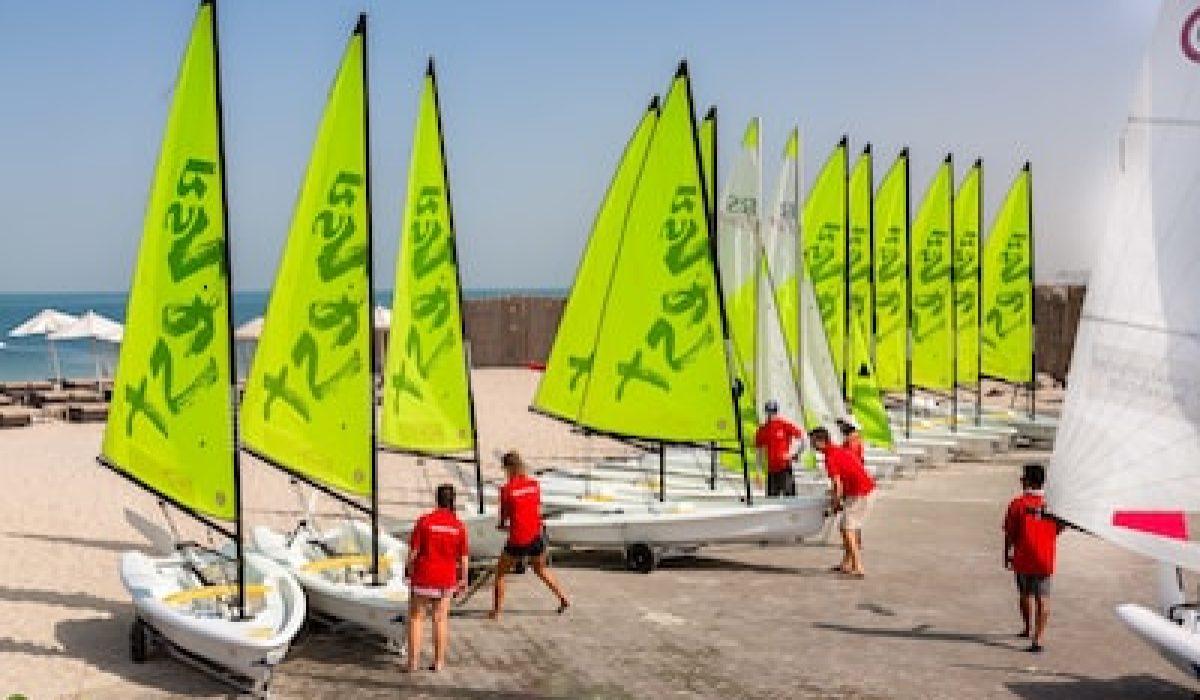Are you an avid sailor looking to embark on solo adventures? Solo sailing can be a thrilling and fulfilling experience, but it also requires careful preparation and consideration. In this blog post, we will explore various aspects of solo sailing, from choosing the right boat and essential navigation tools to preparing for challenging weather conditions and maintaining safety and security. Whether you are a seasoned sailor or a beginner, this guide will provide you with valuable insights and tips to enhance your solo sailing adventures.
Choosing The Right Boat For Solo Sailing
When it comes to embarking on a solo sailing adventure, one of the most crucial decisions you’ll make is selecting the perfect boat. The choice of boat can greatly impact your sailing experience and safety on the open seas. Here are some essential tips to consider when choosing the right boat for your solo sailing endeavor.
1. Size and Stability: When sailing solo, it’s crucial to choose a boat size that you can handle comfortably. A smaller boat may offer better maneuverability, while a larger boat may provide more stability in challenging weather conditions. Consider your sailing skills and physical strength when deciding on the size of your boat. Additionally, opt for a boat with a deep keel or a well-balanced design to ensure stability during your solo voyages.
2. Ease of Handling: As a solo sailor, you’ll be responsible for all the tasks involved in sailing the boat. Therefore, it’s important to choose a boat that is easy to handle single-handedly. Look for features such as a self-tacking jib, roller furling mainsail, and easily accessible controls. These elements will make maneuvering the boat and adjusting sails a breeze, allowing you to focus on navigating the seas.
3. Safety Features: Safety should be a top priority when choosing a boat for solo sailing. Look for essential safety features such as a reliable self-steering system, a well-built hull, and proper safety equipment like life jackets, flares, and a VHF radio. Additionally, consider boats with extra stability and self-righting capabilities, which can be crucial in case of an unexpected capsize.
| Boat Model | Size | Stability | Handling | Safety Features |
|---|---|---|---|---|
| XYZ Sailboat | 30 feet | Excellent | Easy | Self-steering system, self-righting capabilities |
| ABC Yacht | 40 feet | Good | Moderate | VHF radio, safety equipment |
| DEF Catamaran | 35 feet | Very Stable | Effortless | Roller furling mainsail, life jackets |
These are just a few factors to consider when choosing the right boat for your solo sailing adventures. Ultimately, make sure to spend time on the water, test sailing different boats, and consult experienced sailors to get a better understanding of what suits you best. Remember, the right boat can make all the difference in ensuring a successful and enjoyable solo sailing experience.
Essential Navigation Tools For Solo Sailors
Sailing solo can be an incredibly liberating and fulfilling experience. There’s something truly special about being out on the open sea, relying solely on your own skills and intuition to navigate and explore. However, sailing solo also comes with its fair share of challenges, particularly when it comes to navigation. As a solo sailor, it’s crucial to have the right tools and resources at your disposal to ensure a safe and successful journey.
One of the most essential navigation tools for solo sailors is a reliable GPS system. A GPS, or Global Positioning System, uses satellites to determine your exact location on the water. This valuable tool not only helps you navigate from point A to point B, but it also provides information on your speed, heading, and even weather conditions. With a GPS, you can easily plot your course, set waypoints, and ensure you’re staying on track throughout your voyage. It’s a must-have for any solo sailor.
In addition to a GPS, another crucial navigation tool for solo sailors is a reliable compass. While a GPS can provide precise coordinates, a compass is essential for determining your heading and ensuring you’re on the right course. A compass works by using the Earth’s magnetic field to indicate which way is north, allowing you to navigate in any direction. Whether you’re sailing on a clear sunny day or in adverse weather conditions, a compass will always be there to guide you.
Lastly, every solo sailor should consider investing in a marine chart or navigational map. While a GPS can provide a digital representation of your surroundings, having a physical chart or map can be extremely helpful, especially in the case of technical malfunctions or power outages. These charts provide valuable information about the water depth, underwater features, and potential hazards, allowing you to navigate safely and confidently. It’s important to keep your charts up to date and to study them before embarking on any solo sailing adventure.
- GPS: A reliable GPS system is an essential tool for solo sailors, providing precise location information, speed, and weather updates.
- Compass: A compass is crucial for determining your heading and ensuring you’re on the right course, regardless of weather conditions.
- Marine Chart: A physical navigational map is an invaluable resource for solo sailors, providing information on water depth, hazards, and underwater features.
| Tool | Function |
|---|---|
| GPS | Provides precise location information, speed, and weather updates. |
| Compass | Determines heading and ensures you’re on the right course, regardless of weather conditions. |
| Marine Chart | Provides information on water depth, hazards, and underwater features. |
Preparing For Solo Sailing Adventures
Sailing solo can be an exhilarating and rewarding experience, but it also requires careful planning and preparation. Whether you are embarking on your first solo sailing adventure or are a seasoned sailor looking to enhance your skills, here are some essential tips to help you navigate the seas with confidence.
First and foremost, it is crucial to ensure that you choose the right boat for your solo sailing adventures. Choosing the right boat is essential as it will determine the level of comfort and safety you experience during your journey. Consider factors such as size, stability, and ease of handling. A boat with a smaller size and simple rigging may be more manageable for solo sailing.
Equipping yourself with the essential navigation tools is vital for solo sailing. A reliable compass, marine charts, and a GPS are indispensable for accurate navigation. Familiarize yourself with these tools and learn how to use them effectively. Additionally, it is advisable to have backup navigation tools and paper charts in case of technology failures.
Preparing for solo sailing adventures also involves thorough research and planning. Study the planned route, tides, currents, and potential hazards in advance. Create a detailed itinerary including your intended anchorages and destinations. Stay up-to-date with weather reports and make flexible plans to accommodate changing conditions. It is always wise to have multiple contingency plans in case of unexpected challenges.
Navigating solo in challenging weather conditions requires advanced skills and preparation. Ensure you have a solid understanding of weather patterns and how they can impact your journey. Storms, strong winds, and heavy rain can make sailing more demanding, so it is essential to know when to seek shelter or alter your course accordingly. Practice reefing and maneuvering techniques beforehand to handle such situations with confidence.
Maintaining safety and security as a solo sailor should be a top priority. Implementing safety measures such as carrying life jackets, flares, and a first aid kit is crucial. It is also advisable to invest in a reliable personal locator beacon (PLB) or an emergency position indicating radio beacon (EPIRB) to alert authorities in case of emergencies. Stay vigilant, be cautious of other vessels, and always inform someone ashore about your sailing plans.
In conclusion, preparing for solo sailing adventures requires meticulous planning, adequate equipment, and continuous skill development. Choosing the right boat, equipping yourself with essential navigation tools, researching and planning your route, and staying prepared for challenging weather conditions are all key factors to ensure a safe and enjoyable solo sailing experience. Remember to prioritize safety and always maintain a sense of adventure while exploring the vast seas alone.
Navigating Solo In Challenging Weather Conditions
Navigating Solo in Challenging Weather Conditions
Sailing solo can be an incredibly rewarding experience, allowing you to explore the open seas and test your skills as a sailor. However, when faced with challenging weather conditions, it’s crucial to be well-prepared and equipped to ensure your safety. In this blog post, we will discuss some essential tips and strategies to help solo sailors navigate rough weather conditions and ensure a successful voyage.
1. Monitor weather forecasts:
Before setting sail, it’s important to stay updated on the latest weather conditions in the area you plan to navigate. Pay attention to forecasts, including wind speed, wave height, and any potential storm systems. This information will help you make informed decisions about whether it’s safe to proceed or if you need to modify your route or postpone your departure.
2. Plan your route carefully:
When navigating solo in challenging weather conditions, it’s crucial to plan your route with extra caution. Taking into account the expected weather patterns and any potential hazards, such as shallow waters or strong currents, will enable you to choose the safest course. Ensure you have up-to-date nautical charts and plot your course accordingly, avoiding areas prone to adverse weather conditions or other dangers.
3. Be prepared with proper safety equipment:
No matter how experienced you are as a sailor, it’s essential to have the necessary safety equipment onboard when sailing solo in challenging weather. This includes life jackets, harnesses, tethers, and a well-equipped first aid kit. Additionally, consider investing in a reliable EPIRB (Emergency Position Indicating Radio Beacon) and a satellite phone to ensure communication and facilitate a swift rescue in case of an emergency.
Safety Equipment Checklist: Quantity: Life Jackets 1 per person Harnesses and Tethers 1 per person First Aid Kit 1 EPIRB 1 Satellite Phone 1
4. Master storm management techniques:
Encountering storms can be a harrowing experience for solo sailors. It’s crucial to familiarize yourself with storm management techniques to protect your boat and maintain safety. Learning how to properly reef your sails, depower your boat, and maintain balance in heavy winds and rough seas will help you navigate through challenging weather conditions with greater control and confidence.
5. Stay alert and trust your instincts:
When sailing solo in challenging weather, it’s vital to stay alert and trust your instincts. If you have any doubts or feel uncomfortable with the conditions, consider altering your course or seeking shelter until the weather improves. Solo sailing requires self-reliance, but knowing when to prioritize safety over any self-imposed deadlines or goals is paramount.
In conclusion, solo sailors must approach challenging weather conditions with careful planning, the right equipment, and a focus on safety. By monitoring weather forecasts, planning routes diligently, equipping yourself with the necessary safety gear, mastering storm management techniques, and trusting your instincts, you can navigate the seas with confidence and enjoy the thrill of solo sailing while ensuring your own well-being.
Maintaining Safety And Security As A Solo Sailor
Maintaining Safety and Security as a Solo Sailor
Solo sailing can be an exhilarating and fulfilling experience, providing a sense of freedom and adventure that is unmatched. However, it also comes with its own set of challenges and risks that must be carefully managed to ensure your safety and security on the open seas. In this blog post, we will explore some essential tips and strategies for maintaining safety and security as a solo sailor.
1. Prioritize Safety Equipment:
When sailing solo, it is crucial to have the right safety equipment onboard to handle any unforeseen situations. This includes having life jackets, a reliable first aid kit, distress signals, a fire extinguisher, and a well-stocked toolbox for minor repairs. Regularly check and maintain these items to ensure they are in good working condition.
2. Weather Monitoring:
Weather conditions can change rapidly at sea, so it is vital to always stay informed and monitor the weather forecasts. Use reliable tools and instruments such as a barometer, GPS with weather updates, and a VHF radio to keep track of any approaching storms or adverse weather conditions. By anticipating these changes, you can take proactive measures to avoid potential risks.
3. Create a Safety Routine:
Establishing a safety routine is crucial for solo sailors to minimize risks. This routine should include basic safety practices such as checking the boat’s integrity before departure, wearing a harness or safety tether while on deck, and regularly communicating your whereabouts with someone on land. In the event of an emergency, this routine will help you stay calm and provide a clear plan of action.
4. Stay Informed and Practice:
Continuously educate yourself on best practices for sailing safety and security. Attend relevant courses, seminars, or workshops to enhance your skills and knowledge. Additionally, practice emergency drills such as man-overboard scenarios to prepare yourself for unexpected situations. The more you know and practice, the better equipped you will be to handle challenging moments.
5. Stay Well-Rested:
One of the most overlooked aspects of solo sailing safety is adequate rest. Fatigue can impair judgment and reaction times, increasing the risk of accidents. Prioritize proper sleep and rest periods, especially during long journeys. Establish a watch system that allows for regular breaks, ensuring you are refreshed and alert while at sea.
Conclusion:
Maintaining safety and security as a solo sailor requires careful planning, attention to detail, and constant vigilance. By prioritizing safety equipment, monitoring weather conditions, creating a safety routine, staying informed, and ensuring proper rest, you can navigate the seas with confidence and reduced risks. Remember, your safety should always be the top priority while embarking on solo sailing adventures.
Frequently Asked Questions
What factors should I consider when choosing the right boat for solo sailing?
When choosing a boat for solo sailing, consider factors such as size, stability, ease of handling, and safety features. It is important to choose a boat that you feel comfortable and confident in operating alone.
What are some essential navigation tools for solo sailors?
As a solo sailor, essential navigation tools include GPS, compass, charts, binoculars, and an autopilot system. These tools help you navigate accurately, maintain course, and stay aware of your surroundings.
How can I prepare for solo sailing adventures?
To prepare for solo sailing adventures, make sure you have the necessary sailing skills and knowledge. Plan your route, check weather conditions, keep safety equipment onboard, and inform someone about your sailing plans.
How do I navigate solo in challenging weather conditions?
Navigating solo in challenging weather conditions requires careful planning and monitoring. Stay updated with weather forecasts, adjust your sail plan accordingly, and always prioritize your safety. It is advisable to have a backup plan and seek shelter if conditions become unsafe.
What are some measures to maintain safety and security as a solo sailor?
Maintaining safety and security as a solo sailor involves practicing good seamanship, using safety equipment like life jackets and harnesses, staying alert and aware of your surroundings, and regularly checking and maintaining your boat’s systems and equipment.
How important is communication while solo sailing?
Communication is crucial while solo sailing as it allows you to stay connected with the shore, fellow sailors, and emergency services if needed. Carry a reliable communication device such as a VHF radio or satellite phone, and inform someone ashore about your itinerary and expected return.
What are some tips for staying motivated and enjoying solo sailing?
To stay motivated and enjoy solo sailing, set realistic goals, embrace the challenges, and appreciate the solitude and freedom it offers. Stay connected with the sailing community, document your experiences, and always prioritize your safety and wellbeing.




